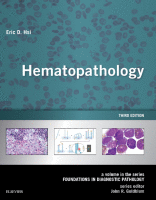Physical Address
304 North Cardinal St.
Dorchester Center, MA 02124

▪ Introduction Molecular investigation of the hematopoietic neoplasms has contributed significantly to our understanding of the “genetic basis” of cancer, and progress in this dynamic field continues unabated. Accordingly, new knowledge concerning recurrent genetic abnormalities in myeloid and lymphoid cancers…

■ Introduction The importance of immunophenotyping in diagnostic hematopathology was first emphasized by the Revised European-American Lymphoma classification, and more recently by the 2001, 2008, and 2016 World Health Organization (WHO) classifications of hematolymphoid neoplasms. In these classifications, nearly all…

▪ Introduction The spleen is a secondary lymphoid organ that functions in the development of the immune response and in blood filtration. In the spleen, blood-borne antigens are presented to lymphocytes and macrophages to facilitate antibody development and cytotoxic immune…

■ Introduction Monoclonal expansion of plasma cells and their precursors gives rise to a spectrum of plasma cell neoplasms ranging from indolent to aggressive. These include monoclonal gammopathy of undetermined significance (MGUS; 67%), multiple myeloma (14%), solitary plasmacytoma of bone…

▪ Introduction Mast cells (MCs) were initially recognized in 1878 by Paul Ehrlich, a Nobel laureate in immunology. They are unique inflammatory mediator cells that contain distinctive metachromatic and electron-dense cytoplasmic granules. MCs derive from bone marrow pluripotent hematopoietic progenitors.…

▪ Derivation of Histiocytes The term histiocyte has come to encompass two cell lines, the monocyte-macrophages and the specialized antigen-presenting dendritic cells (DCs). Although a long-held belief that myeloid-derived monocytes were the immediate precursors of all macrophages and dendritic cells,…

Overview The myelodysplastic syndromes (MDSs) are a heterogeneous group of clonal hematopoietic stem cell disorders characterized by ineffective hematopoiesis. Clinically, this ineffective hematopoiesis manifests as progressive bone marrow failure with cytopenias and a variable probability of progression to acute myeloid…

▪ Introduction Myeloproliferative neoplasms (MPNs), formerly referred to as myeloproliferative disorders, are a group of clonal multipotential hematopoietic stem cell diseases, proliferative in nature. MPNs are frequently associated with hypercellular bone marrow and with an elevation of one or more…

■ Introduction Acute leukemias of ambiguous lineage may be divided into acute undifferentiated leukemia (AUL) and mixed-phenotype acute leukemias (MPALs). AULs are leukemias with very primitive phenotypes that lack definitive lineage-specific antigens. MPAL encompasses rare blastic hematopoietic cell neoplasms that…

▪ Introduction Acute lymphoblastic leukemia (ALL) and lymphoblastic lymphoma (LBL) constitute a biologic continuum of neoplastic lymphoid disorders characterized by the proliferation of immature (blast) cells of B-cell or T-cell lineage. For clinical purposes, an arbitrary cutoff has been used…